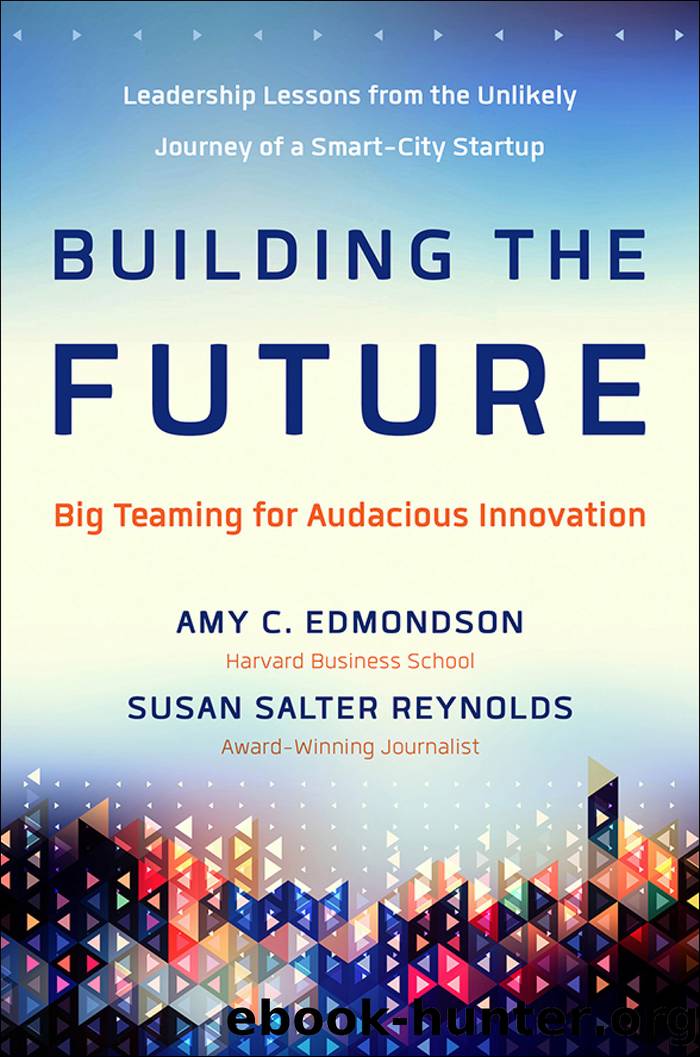Building the Future by Amy C Edmondson

Author:Amy C Edmondson [Edmondson, Amy C]
Language: eng
Format: epub
ISBN: 9781626564213
Publisher: BerrettKoehler
Published: 2016-09-15T05:00:00+00:00
Sensors to the Rescue
One of the transformative innovations in the building space is the use of sensors in the construction process. Meanwhile recent advances in building controls integrate sensors and sophisticated analytics to dramatically improve energy performance.22 Common uses of sensors are in security and in the assessment of environmental conditions, structural states, and resource flow (people, materials, traffic, water, and energy). The use of sensors was of course at the core of Living PlanITâs offering. Hoping to revolutionize the construction process and that of managing buildings and city infrastructure once built, Lewisâs team coded and schemed and sought opportunities to demonstrate their work to the public.
John Stenlake explained in a 2011 interview that the UOS was a platform to take data collected by sensors and sync that data in the cloud (not yet a household word at the time, although used in the tech industry since the mid-1990s).23 Whether to turn on streetlights when needed or to send a firefighting crew to the location of a kitchen fire before an occupant even knew it happened, the UOS would make urban life better. It would do this by collecting and analyzing data on building function, traffic, energy use, and more, and making the data available to applications, accessed through multiple devices, via the cloud. Just as we share photos (data) across smart-phones and laptops using local applications, by sharing content via the cloud, more and more of us would be controlling everything from home thermostats to street parking spaces with the help of Living PlanITâs UOS.
Lewis and Stenlake assured us that privacy and safety were reliably protected in their system. None of this would work without embedding sensors in buildings and infrastructure during construction. Answers to practical questionsâlike how and when in the building process to embed the sensors, whether to build modularly, and how to design buildings to leverage the information that sensors provideâwere still largely unknown in 2011. But it was clear that large shifts in the way construction was carried out and in the culture of the industry were needed. By 2014 some of the challenges of introducing sensors into the construction process had been overcome, at least for individual buildings.
Completed in 2015, the Edge in Amsterdamâtouted as the worldâs smartest office buildingâboasted 28,000 sensors designed to increase human and energy efficiency. The British rating system, BREEAM (Building Research Establishment Environmental Assessment Methodology), called the Edge âthe greenest building in the world.â24 Solar panels cover the southern wall; water from an aquifer beneath the building provides radiant heating and cooling, and a rainwater catchment system is used for toilets and watering the grounds. Consulting firm Deloitte was the buildingâs main tenant in 2015 and expected a return on investment in less than 10 years. The Edge already used 70 percent less electricity than most office buildings and produced more energy than it consumed.25
Photos of the Edge reveal a breathtaking, enviable vision of the future workplace: clean, airy, light, and supremely hip. A smartphone app allows people who
Download
This site does not store any files on its server. We only index and link to content provided by other sites. Please contact the content providers to delete copyright contents if any and email us, we'll remove relevant links or contents immediately.
Bad Blood by John Carreyrou(6584)
Rich Dad Poor Dad by Robert T. Kiyosaki(6515)
Principles: Life and Work by Ray Dalio(6297)
Playing to Win_ How Strategy Really Works by A.G. Lafley & Roger L. Martin(6087)
Management Strategies for the Cloud Revolution: How Cloud Computing Is Transforming Business and Why You Can't Afford to Be Left Behind by Charles Babcock(4548)
The Confidence Code by Katty Kay(4222)
Thinking in Bets by Annie Duke(4186)
American Kingpin by Nick Bilton(3822)
Delivering Happiness by Tony Hsieh(3397)
Project Animal Farm: An Accidental Journey into the Secret World of Farming and the Truth About Our Food by Sonia Faruqi(3191)
The Power of Habit by Charles Duhigg(3097)
The Tyranny of Metrics by Jerry Z. Muller(3031)
Brotopia by Emily Chang(3028)
Mastering Bitcoin: Programming the Open Blockchain by Andreas M. Antonopoulos(3014)
The Marketing Plan Handbook: Develop Big-Picture Marketing Plans for Pennies on the Dollar by Robert W. Bly(3007)
I Live in the Future & Here's How It Works by Nick Bilton(2963)
The Content Trap by Bharat Anand(2889)
Applied Empathy by Michael Ventura(2865)
Building a StoryBrand by Donald Miller(2865)
